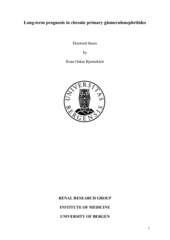| dc.contributor.author | Bjørneklett, Rune Oskar | en_US |
| dc.date.accessioned | 2012-04-02T09:59:37Z | |
| dc.date.available | 2012-04-02T09:59:37Z | |
| dc.date.issued | 2012-03-15 | eng |
| dc.identifier.isbn | 978-82-308-1972-2 | en_US |
| dc.identifier.uri | https://hdl.handle.net/1956/5735 | |
| dc.description.abstract | Chronic primary glomerulonephritides (CPGN) is a group of diseases characterised by leakage of proteins and/or erythrocytes into the urine with or without decreased glomerular filtration rate (GFR), hypertension, oedema, hyperlipidemia and low serum albumin. Although CPGN often are benign conditions, there is an increased risk for development of end-stage renal disease (ESRD), a complication that sometimes can be avoided by using potent, but toxic, immunosuppressive drugs [1]. Patients who develop ESRD need dialysis or kidney transplantation for further survival. However, these treatments are expensive and associated with decreased quality of life and increased mortality risk. Even after having caused destruction of the native kidneys, CPGN may recur in a transplanted kidney and thus cause failure also of this kidney [2]. As the outcomes of patients with CPGN are varied and the treatment options often are toxic and dangerous, selection of patients for appropriate treatment and follow-up regimens is of major importance. A correct histopathological diagnosis is mandatory, but in itself not sufficient, to decide the optimal treatment in individual patients. Within the various diagnoses of CPGN patients, the outcome with regard to risk of ESRD is varied and prognostic parameters are important for optimal treatment decisions. Thus, the study of prognostic factors and the combination of such factors as useful prognostic tools in the various types of CPGN is very important [3-6]. The number of patients with various types of CPGN are relatively low within each group of diseases. In addition, time from diagnosis of renal disease to ESRD may vary from weeks to decades, facts that complicate the study of prognostic factors in patients with such conditions. Although risk of ESRD is their major and most investigated hazard, CPGN patients are also at increased risk of other major clinical complications. One of which is an increased risk of malignant tumors [7]. A complex and multicausal association between malignant diseases and CPGN is described. Malignant tumors may cause CPGN through immunological mechanisms [8], and immunosuppressive drugs used against CPGN increases long term risk of malignancies [9-11] and other unknown mechanisms may also contribute. The Norwegian Kidney Biopsy Registry was established in 1988 and its major goal was to study the epidemiology, aetiology, prognosis and treatment of patients with glomerular and other renal diseases. This registry has now become the largest active kidney biopsy registry in the world, containing information regarding more than 11000 kidney biopsies. The scientific value of the Norwegian Kidney Biopsy Registry is greatly enhanced by the linkage possibilities with other Norwegian medical and population registries such as the Norwegian Nephrology Registry (ESRD), the Norwegian Cancer Registry (cancer), the Norwegian Medical Birth Registry (births and pregnancy complications), the Norwegian Population Registry (survival), the Norwegian Cause of Death Registry, and others. Outcome data regarding patients in the Kidney Biopsy Registry can easily and reliably by collected through record linkage with the other registries using the unique 11 digit Norwegian person number. In the present doctoral thesis, the kidney biopsy registry has been linked to other registries and we were thus able to investigate long-term risk of cancer in membranous nephropathy as well as risk factors for ESRD and risk factors for graft failure after kidney transplantation in IgA nephropathy patients. In our studies we have focused on two different CPGN, membranous nephropathy (MN) and IgA nephropathy (IgAN). The characteristics of these conditions and the basis for our studies are described in the following section. | en_US |
| dc.language.iso | eng | eng |
| dc.publisher | The University of Bergen | eng |
| dc.relation.haspart | Paper I: Rune Bjørneklett, Bjørn Egil Vikse, Einar Svarstad, Knut Aasarød, Leif Bostad, Frøydis Langmark and Bjarne Iversen: Long-Term Risk of Cancer in Membranous Nephropathy Patients. American Journal of Kidney Diseases 50(3): 396-403, September 2007. Full text not available in BORA due to publisher restrictions. The article is available at: <a href="http://dx.doi.org/10.1053/j.ajkd.2007.06.003" target="blank"> http://dx.doi.org/10.1053/j.ajkd.2007.06.003</a> | en_US |
| dc.relation.haspart | Paper II: Rune Bjørneklett, Bjørn Egil Vikse, Leif Bostad, Torbjørn Leivestad and Bjarne Iversen: Long term risk of ESRD in IgAN; validation of Japanese prognostic model in a Norwegian cohort. Nephrology Dialysis Transplantation 27(4): 1485-1491, April 2012. Full text not available in BORA due to publisher restrictions. The article is available at: <a href="http://dx.doi.org/10.1093/ndt/gfr446" target="blank"> http://dx.doi.org/10.1093/ndt/gfr446</a> | en_US |
| dc.relation.haspart | Paper III: Rune Bjørneklett, Bjørn Egil Vikse, Hilde Kloster Smerud, Leif Bostad, Torbjørn Leivestad, Anders Hartmann and Bjarne Iversen: Pretransplant course and risk of kidney transplant failure in IgA nephropathy patients. Clinical Transplantation 25(3): 356-365, May/June 2011. Full text not available in BORA due to publisher restrictions. The article is available at: <a href="http://dx.doi.org/10.1111/j.1399-0012.2011.01424.x" target="blank"> http://dx.doi.org/10.1111/j.1399-0012.2011.01424.x</a> | en_US |
| dc.title | Long-term prognosis in chronic primary glomerulonephritides | en_US |
| dc.type | Doctoral thesis | |
| dc.rights.holder | Copyright the author. All rights reserved | |
| dc.subject.nsi | VDP::Medical disciplines: 700::Clinical medical disciplines: 750::Nephrology, urology: 772 | eng |
